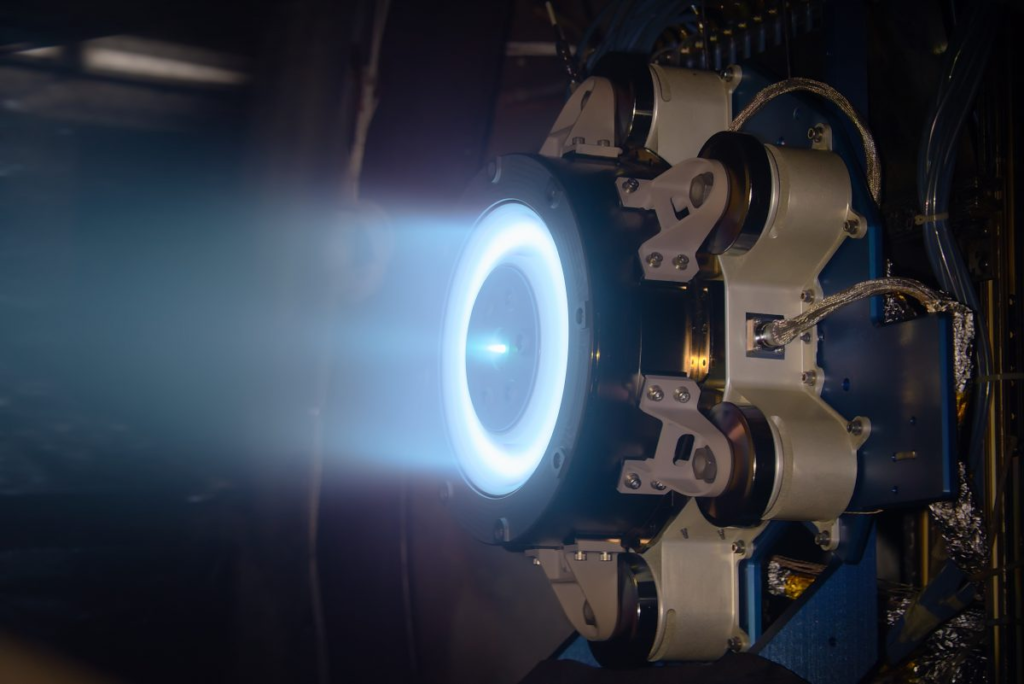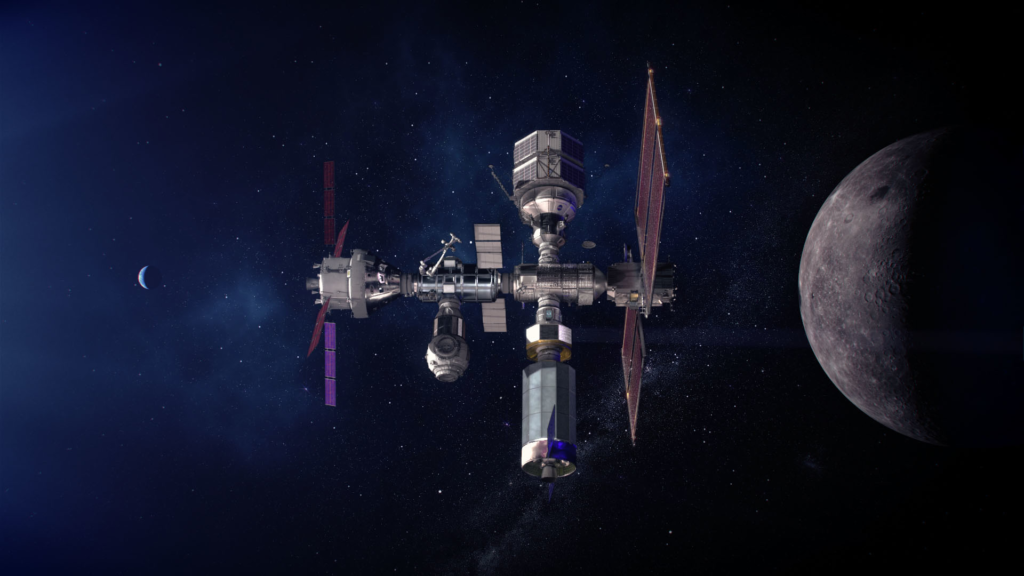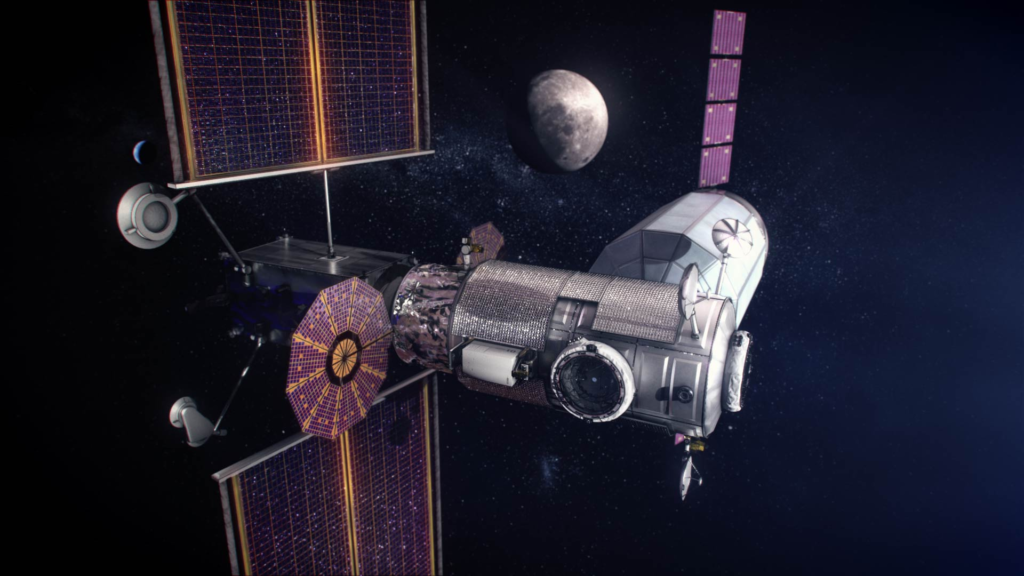
New Progress On The Future Moon Space Station
NASA is trying to make progress on a host of different projects all in preparation for returning humans to the Moon. One of the biggest differences between Artemis and the previous Apollo missions is the infrastructure the agency is working on prior to the missions. A great example is the Moon space station named Gateway, meant to change how we access the surface of the Moon.
Along with recent continued tests of the Space Launch System, the agency is also making progress on Gateway. Specifically, over the past few weeks, NASA provided updates that Gateway is in the midst of several electric propulsion system tests. This is significant as the propulsion system will be vital to the positioning and operation of the station.
In this case, NASA has been conducting an extensive electric propulsion system test campaign to better understand Gateway’s performance during various mission scenarios. Another project helping make progress toward landing humans on the Moon once again. Here I will go more in-depth into the tests being conducted and what to expect in the future regarding Gateway.
Recent Updates

Earlier this month NASA gave an update that the powerhouse of Gateway, NASA’s orbiting outpost around the Moon and a critical piece of infrastructure for Artemis, is in the midst of several electric propulsion system tests. The Power and Propulsion Element (PPE), being manufactured by Maxar Technologies, provides Gateway with power, high-rate communications, and propulsion for maneuvers around the Moon and to transit between different orbits. The PPE will be combined with the Habitation and Logistic Outpost (HALO) before the integrated spacecraft’s launch, targeted for late 2024 aboard a SpaceX Falcon Heavy. Together, these elements will serve as the hub for early Gateway crewed operations and various science and technology demonstrations as the full Gateway station is assembled around it in the coming years.
More recently, the PPE engineering team is conducting an extensive electric propulsion system test campaign to better understand Gateway’s performance during various mission scenarios. The test allows engineers and mission planners to adjust the system to ensure it meets the requirements for exploration of the Moon during Artemis missions. Solar electric propulsion is ideal for Gateway because these systems harness the energy of the Sun, convert it to power, and then use that power to produce long-duration, highly efficient thrust, providing mission flexibility and reduced costs. The PPE will use both a 6-kilowatt (kW) and a 12-kW electric propulsion system. Each system contains various components that help the spacecraft thrust efficiently: thruster(s), power processing units (PPU), flow controllers that regulate the flow of gases, like xenon, used for propulsion, etc. Multiple companies, including prime contractor Maxar as well as Aerojet Rocketdyne and Busek, Co. are supplying electric propulsion technologies for PPE.
They also point out that the developmental versions of the spacecraft’s thrusters and electric propulsion systems are being tested at NASA’s Glenn Research Center in Cleveland. These efforts include the first end-to-end test of the 6-kW system to validate changes and technical interactions between Maxar’s flight-like PPU and Busek’s 6-kW test thruster, as well as validation of Maxar’s larger 12-kW PPU with a prototype 12-kW thruster. The team has also conducted end-to-end tests using Aerojet Rocketdyne’s Advanced Electric Propulsion System (AEPS)12-kW test thruster. The first phase of testing ended in mid-April and successfully demonstrated operations with Aerojet Rocketdyne’s thruster and Maxar’s PPU and Xenon Flow Controller. NASA plans to continue testing PPE’s propulsion system to reduce spacecraft integration and operational risks. During the tests, each system proved capable of performing across the full mission power range and parameters. Additionally, during the tests, the engineering team completed various start up and shut down sequences and thruster throttling to simulate operations around the Moon. These tests for both electric propulsion systems were important for finalizing design, requirements, and capabilities.
The milestone propulsion system tests represent progression through the initial development stage, leading to critical design review, and additional spacecraft ground testing later this year. That ground testing will be followed by spacecraft delivery, and eventual integration with HALO prior to launch. The reliable operation of what will be the highest-power electric propulsion system ever flown is critical for the integrated spacecraft to complete its transit from Earth orbit to lunar orbit. It is vital for Gateway’s operations as a home away from home for astronauts and a lunar microgravity lab supporting Artemis and future missions.
Gateway & Propulsion

Now that we know more about some of the recent tests and progress the station is making, we can take a closer look at its design and propulsion. As partially mentioned prior, Gateway will be an outpost orbiting the Moon that provides vital support for a long-term human return to the lunar surface, as well as a staging point for deep space exploration. It is a critical component of NASA’s Artemis program. Gateway is a vital part of NASA’s deep space exploration plans, along with the Space Launch System (SLS) rocket, Orion spacecraft, and human landing system that will send astronauts to the Moon. Gaining new experiences on and around the Moon will prepare NASA to send the first humans to Mars in the coming years, and the Gateway will play a vital role in this process. It is a destination for astronaut expeditions and science investigations, as well as a port for deep space transportation such as landers en route to the lunar surface or spacecraft embarking to destinations beyond the Moon.
NASA has focused Gateway development on the initial critical elements required to support the landing – the Power and Propulsion Element, the Habitation and Logistics Outpost (HALO), and logistics capabilities. The Habitation and Logistics Outpost will be the initial crew cabin for astronauts visiting the Gateway. Its primary purpose is to provide basic life support needs for the visiting astronauts after they arrive in the Orion and prepare for their trip to the lunar surface. It will provide command, control, and data handling capabilities, energy storage and power distribution, thermal control, communications and tracking capabilities, as well as environmental control and life support systems to augment the Orion spacecraft and support crew members. It also will have several docking ports for visiting vehicles and future modules, as well as space for science and stowage. The HALO is being developed by Northrop Grumman and is managed out of NASA’s Johnson Space Center in Houston.
In terms of logistics, as astronauts prepare for missions to the lunar surface, they will need deliveries of critical pressurized and unpressurized cargo, science experiments and supplies, such as sample collection materials and other items. In March 2020, NASA announced SpaceX as the first U.S. commercial provider under the Gateway Logistics Services contract to deliver cargo and other supplies to the Gateway. One logistics services delivery is anticipated for each crewed Artemis mission to the Gateway. In addition to this, In February 2021, NASA selected SpaceX to provide launch services for PPE and HALO. After integration on Earth, the PPE and HALO are targeted to launch together no earlier than November 2024 on a Falcon Heavy rocket from Launch Complex 39A at Kennedy.
Ion thrusters are being designed for a wide variety of missions—from keeping communications satellites in the proper position (station-keeping) to propelling spacecraft throughout our solar system. These thrusters have high specific impulses, ratio of thrust to the rate of propellant consumption, so they require significantly less propellant for a given mission than would be needed with chemical propulsion. Ion propulsion is even considered to be mission enabling for some cases where sufficient chemical propellant cannot be carried on the spacecraft to accomplish the desired mission. An ion thruster ionizes propellant by adding or removing electrons to produce ions. Most thrusters ionize propellant by electron bombardment: a high-energy electron (negative charge) collides with a propellant atom (neutral charge), releasing electrons from the propellant atom and resulting in a positively charged ion. The gas produced consists of positive ions and negative electrons in proportions that result in no over-all electric charge. These processes and more are expected to help propel Gateway not long from now.
Conclusion
There are a lot of different steps and projects that all need to come together in order for the future Artemis missions to happen and be successful. Gateway is a key part of the plan and recently NASA gave us an update on some of the progress its propulsion system has been making. We will have to wait and see how it progresses and the impact it has on the space industry.
